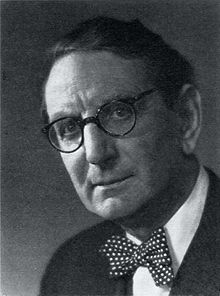Yngve Larsson
Yngve Gustaf Rickard Larsson (born December 13, 1881 in Sundsvall , † December 16, 1977 in Stockholm ) was a Swedish politician , local councilor in Stockholm, member of the Swedish Reichstag and the Folkpartiet liberalerna and Ph. D. ( Philosophiae Doctor ).
During the years 1924-1946 was Larsson road and city building in Stockholm, in this period of time he had as a politician significantly large infrastructure projects led the city, including the occurrence of Stockholm's subway , and the transformation of downtown Stockholm, also Norrmalmsregleringen called .
Years of study and apprenticeship (1900–1924)
Yngve Larsson graduated from high school in Stockholm in 1900 and then studied at Uppsala University . In 1903 he received his bachelor's degree in history and political science , after which he studied in Heidelberg and Berlin .
He became interested in urban planning and housing issues at an early age . In 1913 he wrote his disputation on issues of urbanization . 1912-1918 he was an authoritative member of the Housing Commission ( bostadskommission ). During the First World War he called for “a courageous alliance on Germany's side”, which resulted in his expulsion from the Social Democratic Party by Hjalmar Branting . In 1920 Larsson was elected to the Stockholm city government as secretary and head of the city chancellery.
The years as a local councilor (1924–1946)
In 1924 Yngve Larsson became a local councilor ( borgarråd ) in Stockholm, he held this office until 1946. As political head of the Roads and Town Planning Department , he was instrumental in bringing about the largest construction and infrastructure projects ever carried out in Stockholm. The Slussen transport system (1930–35), the large bridges Västerbrücke and Tranebergsbrücke (1934, 1935), Stockholm's central airport Bromma (1935–36), the Skogskyrkogården forest cemetery (1940, now a UNESCO World Heritage Site ), the Stockholm underground Bahn (1941) and the so-called Norrmalmsregelingen , which means the complete redesign of Stockholm's inner city (carried out 1950–1975). Larsson also played a central role in creating the new Stockholm suburbs.
During the Second World War he was the head of Samfundet Nordens Frihet (roughly ”Association for the Freedom of the Nordic Countries”). Larsson held a clear anti-National Socialist course.
The Elderly Statesman (1946–1977)
After leaving office as local councilor in 1946, Larsson would continue to be actively involved in the politics of Sweden and the city of Stockholm for another 30 years. From 1946 to 1952 he was a member of the second chamber of the Reichstag, from 1955 to 1960 he was deputy chairman of the building and urban planning office and had other assignments in the field of construction and planning in Stockholm. In 1970, at the age of 89, he retired from active politics. In 1966, Yngve Larsson was awarded the "Samfundet S: t Erik" plaque for his praiseworthy commitment to Stockholm .
Larsson was married to Elin Bonnier and a brother-in-law of the German historian and diplomat Friedrich Stieve . One of his sons was the pediatrician Yngve AA Larsson .
Yngve Larsson and his wife Elin are buried on Skogskyrkogården, next to the grave of Gunnar Asplund , one of the two architects of the cemetery.
Works (selection)
- Rudolf Häpke , Sven Helander , Nils Herlitz , Yngve Larsson, Fredrik Sandberg : From Sweden's political and economic life . In: Felix Genzmer (Hrsg.): Writings of the Association for State Science Further Education . tape 6-11 . Gersbach-Verlag, Berlin 1925 ( GoogleBooks ).
swell
- Abbreviated translation from the Swedish Wikipedia: sv: Yngve Larsson
Web links
| personal data | |
|---|---|
| SURNAME | Larsson, Yngve |
| ALTERNATIVE NAMES | Larsson, Yngve Gustav Rickard (full name) |
| BRIEF DESCRIPTION | Swedish politician and member of the Reichstag |
| DATE OF BIRTH | December 13, 1881 |
| PLACE OF BIRTH | Sundsvall |
| DATE OF DEATH | December 16, 1977 |
| Place of death | Stockholm |
